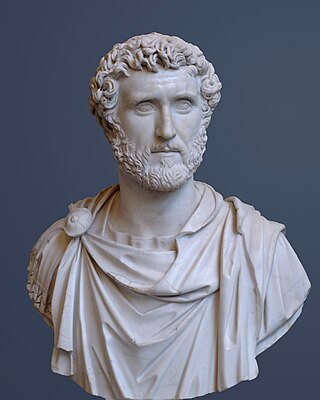
Titus Aelius Hadrianus Antoninus Pius was Roman emperor from AD 138 to 161. He was the fourth of the Five Good Emperors from the Nerva–Antonine dynasty.

Marcus Aurelius Antoninus was Roman emperor from 161 to 180 and a Stoic philosopher. He was a member of the Nerva–Antonine dynasty, the last of the rulers later known as the Five Good Emperors and the last emperor of the Pax Romana, an age of relative peace, calm, and stability for the Roman Empire lasting from 27 BC to 180 AD. He served as Roman consul in 140, 145, and 161.

The 120s was a decade that ran from January 1, AD 120, to December 31, AD 129.

The 130s was a decade that ran from January 1, 130, to December 31, 139.
The 140s decade ran from January 1, 140, to December 31, 149.
The 150s decade ran from January 1, 150, to December 31, 159.
The 160s decade ran from January 1, 160, to December 31, 169.
Year 139 (CXXXIX) was a common year starting on Wednesday of the Julian calendar. At the time, in Western civilization, it was known as the Year of the Consulship of Hadrianus and Praesens. The denomination 139 for this year has been used since the early medieval period, when the Anno Domini calendar era became the prevalent method in Europe for naming years.
Year 161 (CLXI) was a common year starting on Wednesday of the Julian calendar. At the time, it was known as the Year of the Consulship of Caesar and Aurelius. The denomination 161 for this year has been used since the early medieval period, when the Anno Domini calendar era became the prevalent method in Europe for naming years.

Lucius Aurelius Verus was Roman emperor from 161 until his death in 169, alongside his adoptive brother Marcus Aurelius. He was a member of the Nerva–Antonine dynasty. Verus' succession together with Marcus Aurelius marked the first time that the Roman Empire was ruled by more than one emperor simultaneously, an increasingly common occurrence in the later history of the Empire.

Lucius Aelius Caesar was the father of Emperor Lucius Verus. In 136, he was adopted by the reigning emperor Hadrian and named heir to the throne. He died before Hadrian and thus never became emperor. After Lucius' death, he was replaced by Antoninus Pius, who succeeded Hadrian the same year.

Annia Galeria Faustina the Elder, sometimes referred to as Faustina I or Faustina Major, was a Roman empress and wife of the Roman emperor Antoninus Pius. The emperor Marcus Aurelius was her nephew and later became her adopted son, along with Emperor Lucius Verus. She died early in the principate of Antoninus Pius, but continued to be prominently commemorated as a diva, posthumously playing a prominent symbolic role during his reign.

Annia Galeria Faustina the Younger was Roman empress from 161 to her death as the wife of emperor Marcus Aurelius, his maternal cousin. Faustina was the youngest child of emperor Antoninus Pius and empress Faustina the Elder. She was held in high esteem by soldiers and her husband as Augusta and Mater Castrorum and was given divine honours after her death.

The gens Aurelia was a plebeian family at ancient Rome, which flourished from the third century BC to the latest period of the Empire. The first of the Aurelian gens to obtain the consulship was Gaius Aurelius Cotta in 252 BC. From then to the end of the Republic, the Aurelii supplied many distinguished statesmen, before entering a period of relative obscurity under the early emperors. In the latter part of the first century, a family of the Aurelii rose to prominence, obtaining patrician status, and eventually the throne itself. A series of emperors belonged to this family, through birth or adoption, including Marcus Aurelius and the members of the Severan dynasty.

The Nerva–Antonine dynasty comprised seven Roman emperors who ruled from AD 96 to 192: Nerva (96–98), Trajan (98–117), Hadrian (117–138), Antoninus Pius (138–161), Marcus Aurelius (161–180), Lucius Verus (161–169), and Commodus (177–192). The first five of these are commonly known as the "Five Good Emperors".
The gens Aelia, occasionally written Ailia, was a plebeian family in Rome, which flourished from the fifth century BC until at least the third century AD, a period of nearly eight hundred years. The archaic spelling Ailia is found on coins, but must not be confused with Allia, which is a distinct gens. The first member of the family to obtain the consulship was Publius Aelius Paetus in 337 BC.

The early life of Marcus Aurelius spans the time from his birth on 26 April 121 until his accession as Roman emperor on 8 March 161.

The reign of Marcus Aurelius began with his accession on 7 March 161 following the death of his adoptive father, Antoninus Pius, and ended with his own death on 17 March 180. Marcus first ruled jointly with his adoptive brother, Lucius Verus. They shared the throne until Lucius' death in 169. Marcus was succeeded by his son Commodus, who had been made co-emperor in 177.

Avidia was a well-connected noble Roman woman. She is among the lesser known members of the ruling Nerva–Antonine dynasty of the Roman Empire.
Ceionia Fabia was a noble Roman woman and a member of the ruling Nerva–Antonine dynasty of the Roman Empire.












